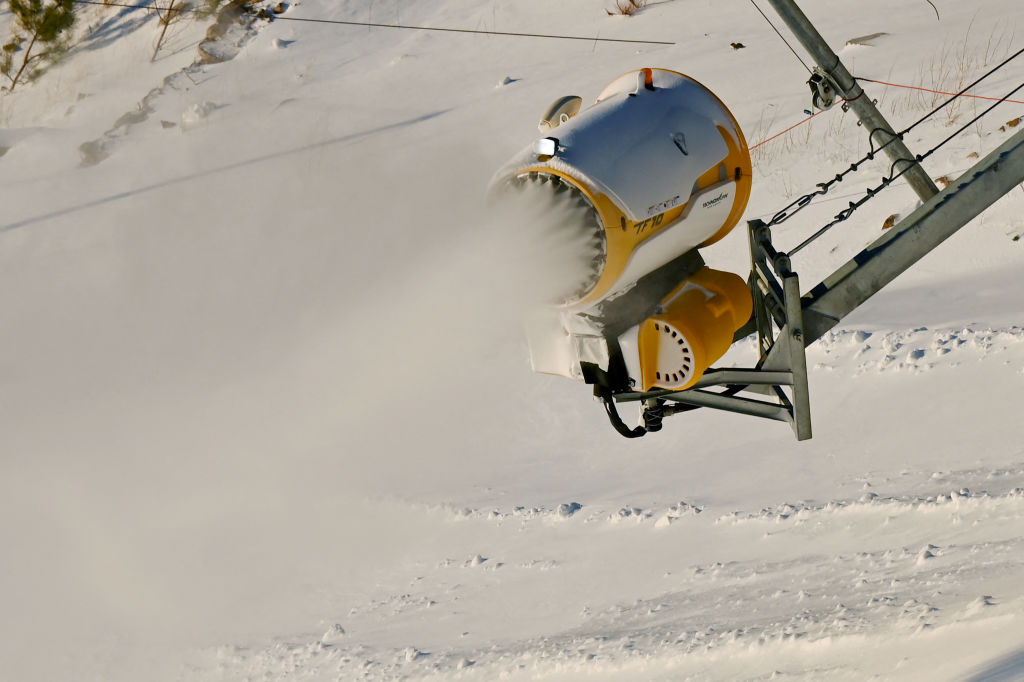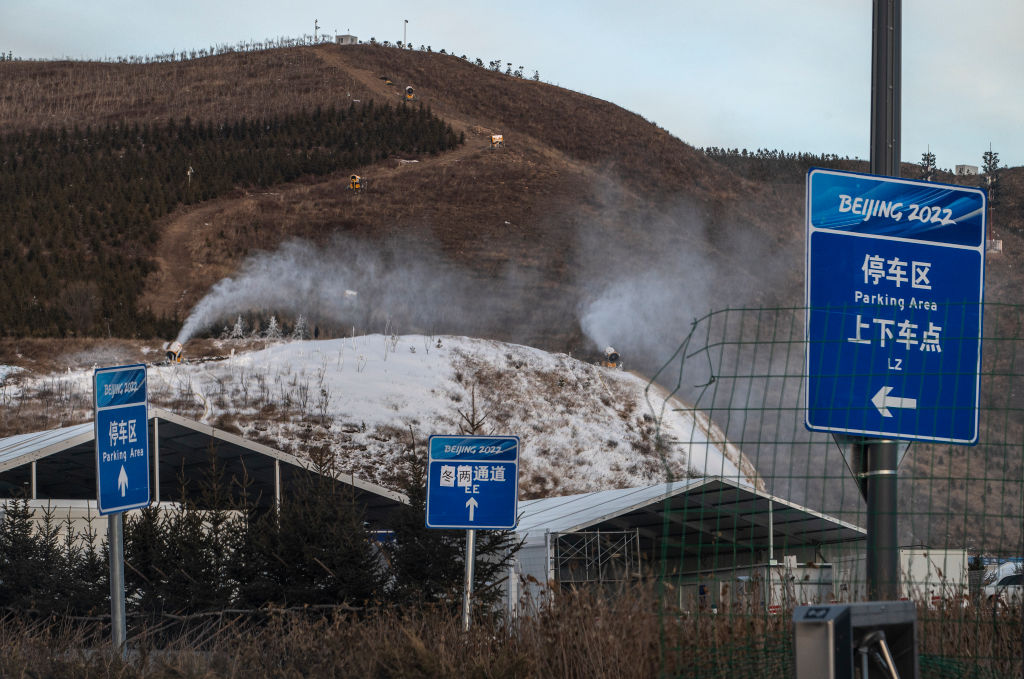One-hundred percent of the snow that athletes at the 2022 Beijing Winter Olympics are competing on is artificial—pumped out by high-powered snow machines, rather than produced by Mother Nature.
The lack of natural snow is a first for the Winter Games—though it’s hardly an anomaly. Artificial snow was first used at the 1980 Winter Olympics in Lake Placid, New York, but it has been growing in prevalence in the most recent Games. About 80% of the snow used in Sochi, Russia in 2014 was artificial, and that number went as high as 98% for the Pyeongchang Games in South Korea in 2018.
But the International Olympic Committee (IOC)’s decision to select a city that must rely on artificial snow, raises questions about how sustainable the Winter Olympics are. Beijing has little to no natural snowfall in the winter, and yet it will stage 109 winter sporting events. To transform terrains, organizers will use almost 300 fan-powered snow guns and 83 lance-style snow guns from Italian firm TechnoAlpin.
Chinese President Xi Jinping has vowed a more “green, inclusive, open and corruption-free” Winter Olympics. Organizers say all venues use renewable energy—primarily solar and wind—to minimize their carbon footprint, with some using a natural carbon dioxide refrigeration system to keep ice rinks frozen. Beijing has also planted tens of thousands of trees in an attempt to offset some of the emissions from the Games.
However, hosting an athletic contest based on snow and ice in a city where the average temperature does not drop below freezing, and which faces chronic water scarcity, is at odds with that goal, critics say. “To rely 100% on artificial snow does signal that the Olympics have landed in a place that is not climatically suitable,” says Madeleine Orr, a sports ecologist at the University of Loughborough in the U.K.
Beijing 2022 may offer a glimpse into the difficult future of the Winter Olympics. New research from the University of Waterloo in Canada shows that the list of cities that could sustainably hold the Winter Olympics is shrinking. If global greenhouse gas emissions are not reduced, only one of the 21 previous locales for the Winter Games—Sapporo, Japan—would have the requisite temperature and precipitation to stage the games by 2080.
Read more: The Alps Are Melting. Climate Change Is to Blame

The advantages (and disadvantages) of artificial snow
Michael Mayr, TechnoAlpin’s Area Manager for Asia, tells TIME that the composition of machine-made snow is just air and water—not much different from natural snow. The IOC says no chemical additives were added to the snow-making process for the National Alpine Skiing Centre in Yanqing, as well as the Guyangshu Venue Cluster and Genting Snow Park in Zhangjiakou.
The only difference, Mayr says, is that snow machines can generate different types of snow, depending on the athletes’ needs. “For the alpine venues, we need very icy snow,” Mayr says. “On the freestyle venues, we need a little bit softer snow. We thus can set the quality [for all] all of that. It’s the perfect snow for athletes.”
Some athletes have flagged dangers linked to artificial snow; Estonian Olympic biathlete Johanna Taliharm told the Associated Press earlier that machine-made snow is “icier” and thus “faster and more dangerous.”
The International Ski Federation (FIS) disputes the danger associated with artificial snow, and adds that World Cup competitions use this regularly. FIS Chief Race Director for the Men’s Alpine Ski World Cup Markus Waldner says that aside from being safe, using man-made snow ensures that the conditions are uniform for all competitors.
“If you watch our World Cup events in Europe you know [the snow is] very hard—it’s nearly ice,” Waldner says. “But exactly this is what the guys want.”
Beijing’s water shortage
Temperatures in Beijing are often at their coldest during the start of the year, but the average stays above the freezing point. Based on data from the World Meteorological Organization, February temperatures in Beijing during the day can rise to 39°F, but also can fall to several degrees below freezing overnight. But since the region has a semi-arid climate, average daily precipitation from November to February ranges from less than one-tenth of an inch, to one-quarter of an inch.
China is estimated to pay more than $60 million for the snow machines used at the Olympics. Wind and solar energy will be used to power these snow generators, according to the IOC. But to generate enough snow, the country estimates it will need more than 49 million gallons of water.
That poses a problem for the Chinese capital, where the 21 million residents are living with decades-long water scarcity. Data from the Ministry of Water Resources, collected by analytics firm CEIC, shows that Beijing has around 31,000 gallons of available water per capita per year, which is one-twentieth of the national average. Neighboring Hebei, where the Zhangjiakou zone is, has 51,000 gallons of water resources per capita yearly. But both regions are well below the 449,000 gallon per capita threshold for water sufficiency, by United Nations definitions. (To address this shortage, water from China’s south has been diverted to the north where Beijing and Tianjin are.)
In 2015, the IOC assessed that Beijing’s Olympic organizing committee may have underestimated how much water would be used to create the snow and identified it as a risk. But in a report released weeks before the Games, Beijing said that snowmaking will have minimal or no impact on local water supply since collected rainfall and surface runoff will be used.
Sports ecologist Orr believes water use figures could climb even higher if the temperature does. “If the temperature goes up a little bit, and you have a little bit of snow melt during the day, and if that happens several days in a row, you could very easily be in a situation where the organizers would have to replace a lot of snow throughout the event and produce it on an ongoing basis.” So far, however, temperatures are near normal ranges.
Though some have criticized Beijing’s reliance on artificial snow, it is commonly used to supplement natural snow at ski resorts around the world. It’s becoming increasingly necessary to keep even the Alps and the American Rocky Mountains skiable.

The future of the Winter Games
Warm weather is becoming increasingly common in Winter Games. During the 2006 Games in Turin, Italy, temperatures were slightly above freezing, but went as high as 52 degrees. Eight years later in Sochi, the average temperature was 50 degrees, making it one of the warmest Winter Olympics host cities. But more than being outliers, these temperatures may just bode the warming future of the Winter Olympiad.
In 2026, the Winter Games will return to Cortina d’Ampezzo and Milan in Italy after 70 years. When Cortina d’Ampezzo welcomed the Olympics in 1956, heavy snow fell on the first day. But an analysis from nonprofit research group Climate Central found that since the Olympics, the average temperature for Milan in February has warmed by 5.9 degrees in the intervening time.
If this trend continues worldwide, not even artificial snow can save the future of the Winter Olympics in a warming world. Orr co-authored a recent study about how man-made global warming threatens the future of the Winter Olympiad, and winter sports in general. In the study, the authors note the dwindling number of cities that will remain viable for winter games as global carbon emissions raise temperatures and make things like snowfall less predictable.
Beijing, according to the report, will no longer be able to reliably stage the Winter Olympics by 2050 under existing conditions—even artificial snow can only successfully substitute for natural snow if temperatures are low enough to keep it from melting. “If we have certain mountain regions that are just too warm, no amount of snowmaking is going to fix that,” Orr says.
The IOC has pledged that all Games will have a “significantly reduced” carbon footprint by 2030 in line with its “climate positive” goals. But Orr thinks the committee should consider the broader climate suitability of a host city before accepting its bid, including the environmental impact and costs.
She adds that the IOC should mull over downscaling the Olympics to cut its carbon footprint, as it already is doing in the context of the COVID-19 pandemic. The Games can take advantage of mass digital media coverage of sporting events, prioritizing local spectators as well as athletes’ friends and family to attend the games in-person instead of using the Games as a tourism vehicle. “I think that the opportunity moving forward is [to] change the scope of the on the ground footprint of these events so that smaller places can afford to do it,” Orr says. “And the environmental footprint isn’t crazy.”
More Must-Reads from TIME
- Cybersecurity Experts Are Sounding the Alarm on DOGE
- Meet the 2025 Women of the Year
- The Harsh Truth About Disability Inclusion
- Why Do More Young Adults Have Cancer?
- Colman Domingo Leads With Radical Love
- How to Get Better at Doing Things Alone
- Michelle Zauner Stares Down the Darkness
Contact us at letters@time.com